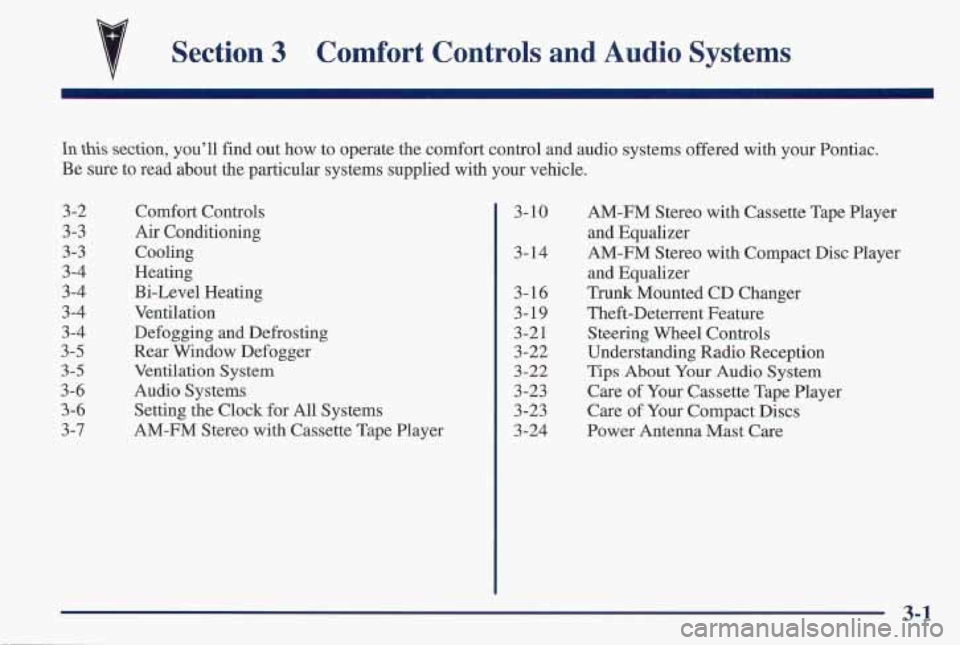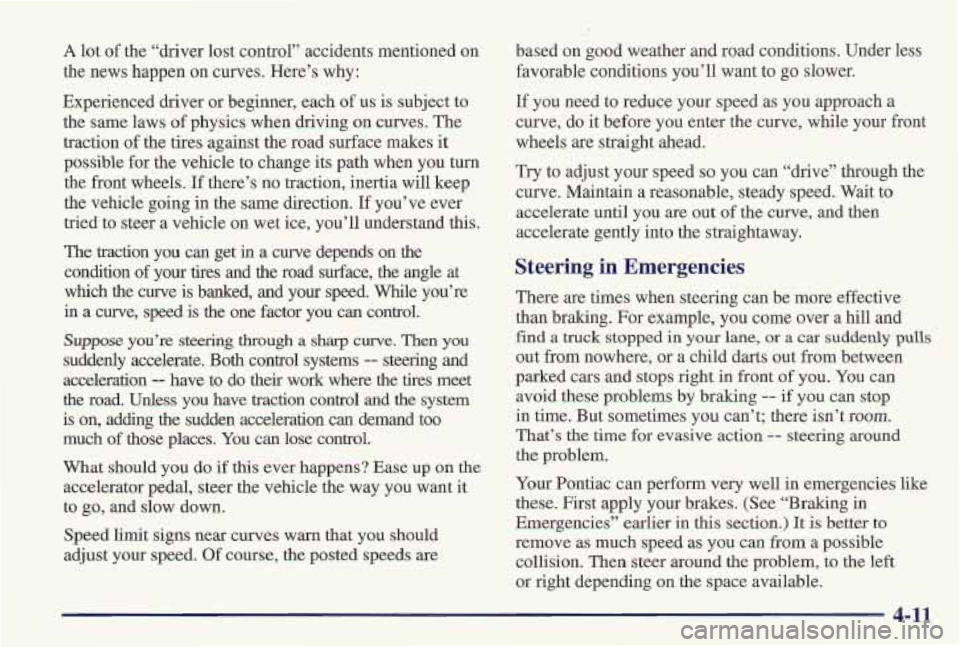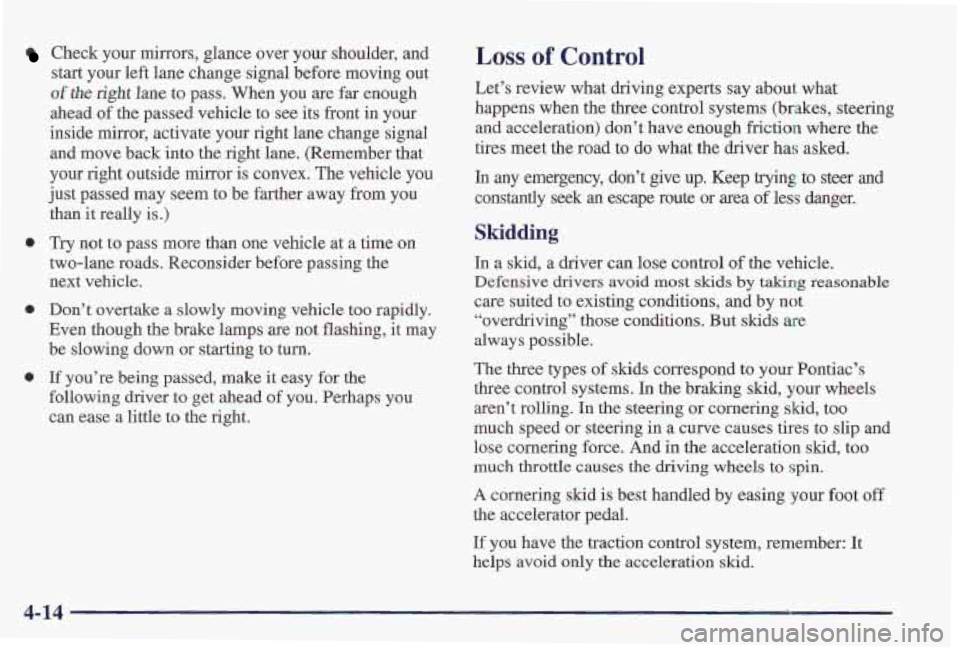steering PONTIAC FIREBIRD 1997 User Guide
[x] Cancel search | Manufacturer: PONTIAC, Model Year: 1997, Model line: FIREBIRD, Model: PONTIAC FIREBIRD 1997Pages: 410, PDF Size: 19.2 MB
Page 93 of 410

Tilt Steering Wheel Thrn SignaVMultifunction Lever
A tilt steering wheel allows you to adjust the steering
wheel before
you drive.
You can also raise it to the highest level to give your
legs more room when
you exit and enter the vehicle.
To tilt the wheel, hold the steering wheel and pull the
lever. Move the steering wheel to
a comfortable level,
then release the lever to lock the wheel in place.
The lever on the left side of the steering column
includes your:
0 Turn Signal and Lane Chaaage Indicator
0 Headlamp HighLow Beam Changer and
Passing Signal
Windshield Wipers
Windshield Washer
Cruise Control (Option)
2-44
Page 124 of 410

A. Fog Lamp Switch (If Equipped)
B. Main Lamp Control
C. Air Vent
D. Instrument Cluster
E.
Horn
E Audio System
G. Glove Box
H. Comfort Controls
I. Cupholder
J. Parking Brake Lever
K.
Storage Console
L. Rear Window Defogger Switch
M. Convertible Top Switch (Automatic) (If Equipped)
N. Traction Control System Switch or Second Gear
0. Cigarette Lighter
P. Shift Lever
Q. Ashtray (Automatic Transmission)
R. Convertible Top Switch (Manual) (If Equipped)
S. Steering Wheel Controls
T. Remote Hatch Release
Start
Switch (If Equipped)
Page 140 of 410

Section 3 Comfort Controls and Audio Systems
In this section, you’ll find out how to operate the comfort control and audio systems offered with your Pontiac.
Be sure to read about the particular systems supplied with your vehicle.
3-2
3-3
3-3
3-4
3-4
3-4
3
-4
3-5
3-5
3-6
3 -6
3-7
Comfort Controls
Air Conditioning
Cooling
Heating
Bi-Level Heating
Ventilation
Defogging and Defrosting
Rear Window Defogger
Ventilation System
Audio Systems Setting the Clock
for All Systems
AM-FM Stereo with Cassette Tape Player
3-10
3- 14
3-16
3-19
3-2
1
3-22
3-22
3-23
3-23
3-24 AM-FM Stereo with Cassette
Tape Player
and Equalizer
AM-FM Stereo with Compact Disc Player
and Equalizer
Trunk Mounted
CD Changer
Theft-Deterrent Feature
Steering Wheel Controls
Understanding Radio Reception
Tips About Your Audio System
Care
of Your Cassette Tape Player
Care
of Your Compact Discs
Power Antenna Mast Care
3-1
Page 160 of 410

Steering Wheel Controls (If Equipped)
If your vehicle has this feature, you can control certain
radio and compact disc functions using the buttons on
your steering wheel.
VOLUME: Press the up or down arrow to increase or
decrease volume.
PLAY: Press this button to play a cassette tape or
compact disc when the radio is playing.
MUTE: Press this button t'o silence the system. Press it
again to turn
on the sound.
SEEK: Press the up arrow to tune to the next radio
station and the down arrow to tune to the previous radio
station. If a cassette tape
or compact disc is playing, the
player will advance with the
up arrow and rewind with
the down arrow.
PRESET Press this button to hear the radio stations
that are set on your pushbuttons. Pressing this button
while playing
a tape will cause the tape to change sides.
If it is pressed while playing a CD, the CD random
feature can be turned
off and on. If this button is pressed
when using the optional 12-disc changer, the changer
will select the next
,disc available.
AM-FM: Press this button to select AM, FM1 or FM2.
If a cassette tape or compact disc is playing, the tape or
disc will stop playing and
the radio will play. If this
button is pressed with a CD in the CD changer, the disc
will go to the next selection.
3-21
Page 166 of 410

Section 4 Your Driving and the Road
Here you’ll find information about driving on different kinds\
of roads and in varying weather conditions. We’ve also
included many other useful tips on driving.
4-2
4-2
4-5
4-6
4-10
4-12
4-13
4- 14
4-15
Defensive Driving
Drunken Driving
Control of a Vehicle
Braking
Steering
Off-Road Recovery
Passing
Loss of Control
Driving at Night
4- 17 Driving in Rain and on Wet Roads
4-20 City Driving
4-22 Before Leaving on a Long Trip
4-25 Winter Driving
4-32 Towing a Trailer
4-2 1 Freeway Driving
4-23 Hill and Mountain Roads
4-30 Loading Your Vehicle
4-1
Page 170 of 410

Drinking and then driving is very dangerous.
Your reflexes, perceptions, attentiveness and
judgment can be affected by even
a small amount
of alcohol. You can have a serious -- or even
fatal
-- collision if you drive after drinking.
Please don’t drink and drive or ride with
a driver
who has been drinking. Ride home in
a cab; or if
you’re with
a group, designate a driver who will
not drink.
Control of a Vehicle
You have three systems that make your vehicle go where
you want it to
go. They are the brakes, the steering and
the accelerator. All three systems have
to do their work
at the places where the tires meet the road. Sometimes,
as when you’re driving
on snow or ice, it’s
easy to ask more
of those control systems than the tires
and road can provide. That means
you can lose control
of your vehicle.
Page 175 of 410

To turn the system off, press
the button located at the
front
of the console.
The light on
the switch will go off, and the traction
control system warning light will come on and stay on.
If the traction control system is limiting wheel spin
when
you press the switch, the light on the switch will
go off and the warning light will come on -- but the
system won’t turn
off right away. It will wait until
there’s
no longer a current need to limit wheel spin.
You can turn the system back on at any time by pressing
the switch again. The light
on the button should come
on, and the traction control system warning light should
go off. If
your car is equipped with P245/5OZR16 tires, the
traction control system will automatically turn
off at
speeds above 108 mph
(174 km/h). (The traction control
system warning light will not come on.) When the
vehicle speed drops below
103 mph (166 kmh) the
system will automatically come on again.
Braking in Emergencies
With anti-lock, you can steer and brake at the same
time.
In many emergencies, steering can help you more
than even the very best braking.
Steering
Power Steering
If you lose power steering assist because the engine
stops or the system is not functioning, you can steer but
it will take much more effort.
Steering Tips
Driving on Curves
It’s important to take curves at a reasonable speed.
4- 10
Page 176 of 410

A lot of the “driver lost control” accidents mentioned on
the news happen on curves. Here’s why:
Experienced driver or beginner, each
of us is subject to
the same laws of physics when driving on curves. The
traction
of the tires against the road surface makes it
possible for the vehicle to change its path when you turn
the front wheels. If there’s no traction, inertia will keep
the vehicle going in the same direction. If you’ve ever
tried to steer a vehicle on wet ice, you’ll understand this.
The traction you can get in a curve depends on the
condition of your tires and the road surface, the angle at
which the curve is banked, and your speed. While you’re
in a curve, speed is
the one factor you can control.
Suppose you’re steering through a sharp curve. Then you
suddenly accelerate. Both control systems -- steering and
acceleration
-- have to do their work where the tires meet
the road. Unless you have traction control and the system
is on, adding the sudden acceleration can demand too
much of
those places. You can lose control.
What should you do if this ever happens? Ease up
on the
accelerator pedal, steer the vehicle the way you want it
to
go, and slow down.
Speed limit signs near curves warn that you should
adjust your speed. Of course, the posted speeds are based
on good weather and road conditions. Under less
favorable conditions you’ll want to go slower.
If you need to reduce your speed as you approach
a
curve, do it before you enter the curve, while your front
wheels are straight ahead.
Try to adjust your speed
so you can “drive” through the
curve. Maintain a reasonable, steady speed. Wait to
accelerate until you are out of the curve, and then
accelerate gently into the straightaway.
Steering in Emergencies
There are times when steering can be more effective
than braking. For example, you come over a hill and
find a truck stopped in your lane, or a car suddenly pulls
out from nowhere, or a child darts out from between
parked cars and stops right in front of you. You can
avoid these problems by braking
-- if you can stop
in time. But sometimes you can’t; there isn’t
room.
That’s the time for evasive action -- steering around
the problem.
Your Pontiac can perform very well in emergencies like
these. First apply your brakes. (See “Braking in
Emergencies” earlier in this section.)
It is better to
remove as much speed as you can from a possible
collision. Then steer around the problem,
to the left
or right depending on the space available.
4-11
Page 177 of 410

Off-Road Recovery
You may find sometime that your right wheels have
dropped
off the edge of a road onto the shoulder while
you’re driving.
An emergency like this requires close attention and a
quick decision. If you are holding the steering wheel at
the recommended
9 and 3 o’clock positions, you can
turn
it a full 180 degrees very quickly without removing
either hand. But you have
to act fast, steer quickly, and
just
as quickly straighten the wheel once you have
avoided the object.
The fact that such emergency situations are always
possible
is a good reason to practice defensive driving at
all times and wear safety belts properly.
I OFF-ROAD RECOVERY / ,
I
I
’/// edge of paved surface
If the level of the shoulder is only slightly below the
pavement, recovery should be fairly easy. Ease
off the
accelerator and then, if there is nothing in the way, steer so
that your vehicle straddles the edge of the pavement. You
can
turn the steering wheel up to one-quarter turn until the
right front tire contacts the pavement edge. Then turn your
steering wheel to
go straight down the roadway.
4-12
Page 179 of 410

Check your mirrors, glance over your shoulder, and
start your left lane change signal before moving out
of the right lane to pass. When you are far enough
ahead
of the passed vehicle to see its front in your
inside mirror, activate your right lane change signal
and move back into the right lane. (Remember that
your right outside mirror is convex. The vehicle
you
just passed may seem to be farther away from you
than it really is.)
0 Try not to pass more than one vehicle at a time on
two-lane roads. Reconsider before passing the
next vehicle.
0 Don’t overtake a slowly moving vehicle too rapidly.
Even though the brake lamps
are not flashing, it may
be slowing down or starting to turn.
0 If you’re being passed, make it easy for the
following driver to get ahead
of you. Perhaps you
can ease a little to
the right.
Loss of Control
Let’s review what driving experts say about what
happens when the three control systems (brakes, steering
and acceleration) don’t have enough friction where the
tires meet the road to do what the driver has asked.
In any emergency, don’t give up. Keep trying to steer and
constantly seek an escape route or area of less danger.
Skidding
In a skid, a driver can lose control of the vehicle.
Defensive drivers avoid most skids by taking reasonable
care suited to existing conditions, and by not
“overdriving” those conditions. But skids are
always possible.
The three types of skids correspond
to your Pontiac’s
three control systems. In the braking skid, your wheels
aren’t rolling. In the steering or cornering skid, too
much speed or steering in a curve causes tires to slip and
lose cornering force. And in
the acceleration skid, too
much throttle causes the driving wheels to spin.
A cornering skid
is best handled by easing your foot off
the accelerator pedal.
If
you have the traction control system, remember: It
helps avoid only the acceleration skid.
4-14